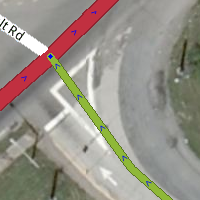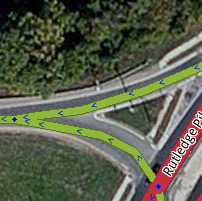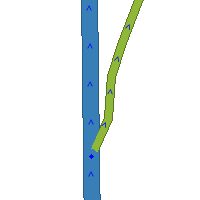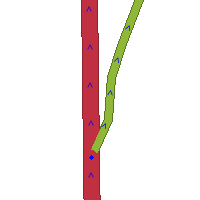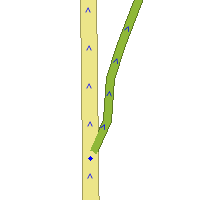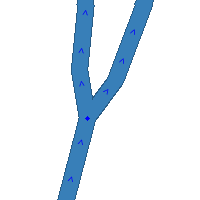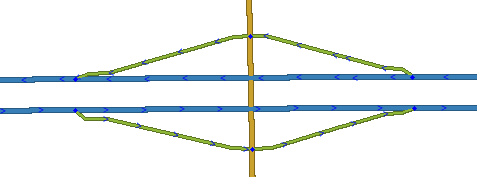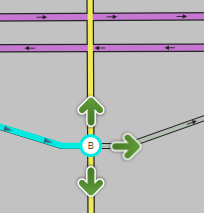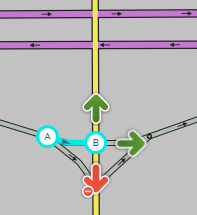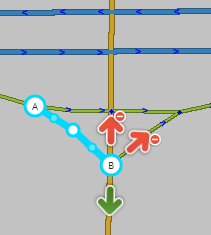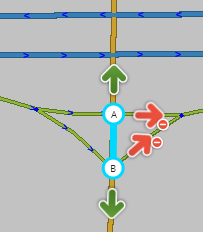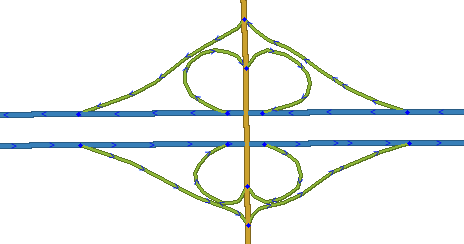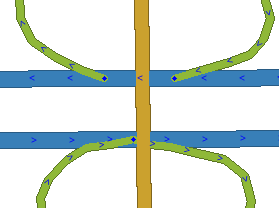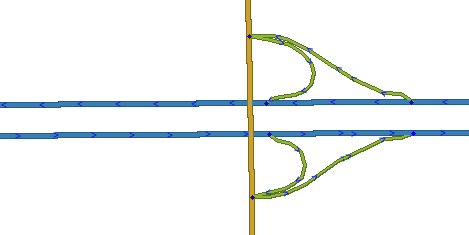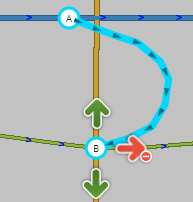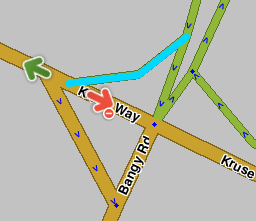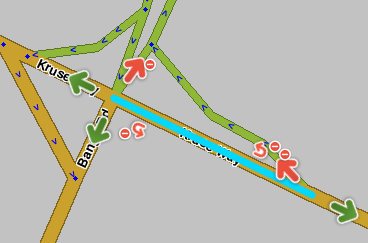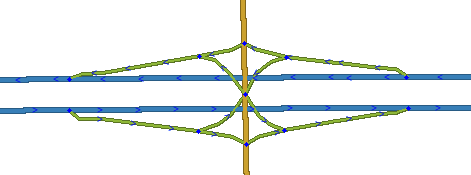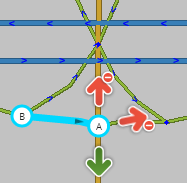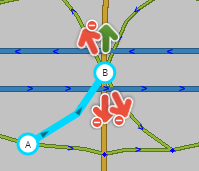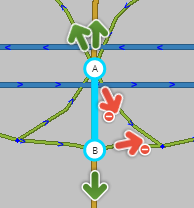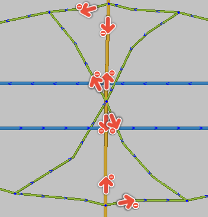An interchange is a road junction where two roads are connected by dedicated roadways, called ramps. The roads connected by an interchange do not intersect one another directly, and if they cross, the crossing is grade-separated.
Since interchanges often involve grade-separated crossings, the road elevation of the segments becomes important. If two roads cross without connecting directly, their elevations must be different.
This article is a sub-article of the Junction Style Guide. As such, this article is a style guide as well. The following sections discuss the proper style for ramps, interchanges, and some common Interchange designs. Note that some interchanges may be a hybrid of these basic designs where one side or quadrant of the interchange may differ from the others.
Before reading through this article, be sure to fully understand the information in the Junction Style Guide.
Ramps
Ramps have a very specific purpose in Waze. They are intended to connect segments of minor highways, major highways, and freeways to roads where there are no at-grade crossings.
The Ramp type is used extensively in interchanges for three reasons.
- Ramp segment names are not displayed on the map.
- Ramp segments have essentially no penalty, so they can be used to connect freeways and major highways with each other without causing problems.
- Ramp segments are relatively small but show at high zoom levels, so interchanges do not distract from highways but can be seen at high speeds.
When to use ramps
Use of the Ramp type is governed by the following rules:
Ramp geometry and complexity
When placing the beginning of a ramp at any exit or fork, first place a geometry node of the ramp segment at the point where the solid white line begins, and extend the ramp naturally to create a junction with the road segment, such that the ramp would diverge 10-15° from the path of the incoming highway/freeway segment. This will allow for consistent timing of exit instructions. However, since it is difficult to distinguish between segments that diverge at small angles when reporting closures in the Waze client, where a straight outgoing segment exists, place an additional geometry node closer to the junction node to increase the divergence angle to at least 20°.
 Sometimes the exit sign and solid white line are placed a significant distance before the gore (where lane markings diverge) of the exit. The junction should begin at the solid white line, unless the solid white line begins more than a quarter mile before the gore point of the exit.
Sometimes the exit sign and solid white line are placed a significant distance before the gore (where lane markings diverge) of the exit. The junction should begin at the solid white line, unless the solid white line begins more than a quarter mile before the gore point of the exit.
 Likewise, at the end of an entrance ramp place a geometry node at the end of the solid white line and extend the ramp to join with the highway at a 10-15° divergence angle. There is no need to use another geometry node to increase the angle, since there is no difficulty in reporting closures here. This will allow for consistent auto-zoom functionality—the client remains zoomed in for the duration of the ramp, zooming out when the user gets on the freeway.
Likewise, at the end of an entrance ramp place a geometry node at the end of the solid white line and extend the ramp to join with the highway at a 10-15° divergence angle. There is no need to use another geometry node to increase the angle, since there is no difficulty in reporting closures here. This will allow for consistent auto-zoom functionality—the client remains zoomed in for the duration of the ramp, zooming out when the user gets on the freeway.

Rule #1 is still simpler is better. If there is no large distance between paths at the end of a ramp (either into or out of the ramp), a single segment connecting to a single junction node is all that is needed. The existence of a painted, concrete, or grass island is not enough of a reason to divide a ramp into multiple ramps.
When paths at the end of the ramp deviate significantly in distance, regardless of the existence of any type of island, then multiple ramps should be used.
Component junction types
Interchanges are made up of multiple individual junctions involving the following:
- One or more highways, represented by the three highway road types Minor Highway , Major Highway , and Freeway
- Grade-separated cross streets which may be highways or lower road types such as Primary Street
- Ramps to join them
Specific examples of how to handle common junction types are provided in the following sections. All of those examples use these road types. If you are unsure what road type you should use, refer to the road types article.
Basic exit
A basic exit exists when a "straight" direction is obvious to a driver and navigation instructions are only needed for the non-straight direction (the exit).
To be treated as a basic exit, the following must be true:
- The entering segment and the continuing segment must be Freeway , Major Highway , or Minor Highway type,
- The freeway/Highway continuing segment should have close to a zero degree departure angle from the entering segment,
- The other exiting segment must be of the type Ramp , and
- The Ramp exiting segment should have a departure angle around 10–15 degrees from the entering segment, as explained above.
When those conditions are met and the ramp exits to the right, the navigation will present an "exit right" instruction when the ramp is to be used, and will remain silent when the continuing freeway/highway segment is to be used. When those conditions are met and the ramps exits to the left, the default instruction in the USA is "stay to the left." A turn instruction override should be used to provide an "exit left" instruction at basic exits where the exit ramp departs the highway to the left.
Basic exit geometry
See #Ramp geometry and complexity for information on setting the angles of basic exits.
Basic exit naming
The highway/freeway segments before and after the junction should be named the same. The ramp segments should be named in accordance with the section on exit ramp names.
Complex exit
A complex exit exists where an exit ramp leaves the highway, and another instruction is needed at the junction with the exit ramp for traffic continuing on the highway. This can be a "keep" or "continue" instruction. The geometry should match the instruction given, so for "continue" instructions the geometry should be set up as described for exits in ramp geometry and complexity, and for keep instructions (wayfinder exits), the geometry should be set up in the same way as a freeway fork. For criteria and further details on mapping complex exits, see wayfinder and turn instruction override.
Freeway/highway fork
A highway/freeway fork is when a highway/freeway segment meets at a junction with two other Highway/Freeway segments and there is no obvious straight through direction to a driver. This is synonymous with the MUTCD term "split."
To create a default navigation instruction for both branches of a fork, the following must be true:
- Both exiting segments must be the same type (freeway, major highway, minor highway).
- Each exiting segment must have a name which is different from the name of the entering segment.
- The two exiting segments should have departure angles deviating around 10-15° from the entering segment and must have departure angles deviating less than 45° from the incoming segment.
With those conditions met, the junction will present "keep right" and "keep left" navigation instructions using the name of the appropriate exiting segment.
Freeway fork geometry
Place the first geometry node of each outgoing segment at the beginning of the solid white line where the roadways diverge, then move the junction node to where each outgoing segment deviates from the incoming segment 10-15° right and left.
Freeway fork naming
The important thing is to give instructions for both right and left side of the fork. That can be accomplished in one of two ways:
- Using signs and wayfinder stub segments: If an outgoing segment has a big green sign (BGS) above it that says something different than the name of the entering segment, cut the segment at the fork to create a stub and name it according to what is on the sign.
- Using a turn instruction override: If one branch is named the same as the entering segment, and there is no sign above it that says anything different from the entering segment, use a turn instruction override to give a "stay to the left" or "stay to the right" instruction depending upon which direction the branch leaves the fork.
Ramp fork
A ramp may itself fork and branch into two directions. If this is the case, "keep right" and "keep left" will be announced using the name or inherited name of the appropriate exiting segment by default. This is synonymous with the MUTCD term "bifurcation."
Ramp fork geometry
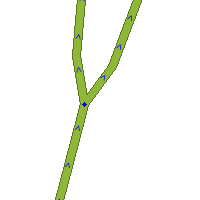
- Ramp forks should generally have the same geometry as freeway forks, except for where the ramp fork is part of a collector/distributor interchange if one side of the ramp fork is using a "continue" instruction. In this case the ramp fork should look more like a basic exit.
Ramp fork naming
Naming of ramps in ramp forks should generally follow the guidelines from road names, with some particular considerations.
Unnamed exit ramp
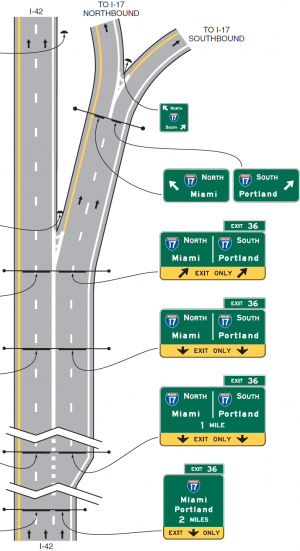
If a ramp is unnamed ("no name" box checked), the name of a subsequent ramp on the route will propagate backwards in navigation instructions. This is useful both for the sake of simplicity and for giving more specific instructions to traffic at exits with ramp forks. If an unnamed ramp is used at an exit and subsequent named ramps are used after the fork, drivers will only see the name of whichever side of the fork they need to go to before they exit the highway. This method will provide more sufficient notification of an approaching decision point than a named exit ramp would, and it should be used as long as the names of both ramp forks are visible on signs at the start of the initial ramp. If an exit ramp has multiple lanes with a sign or part of a sign over each lane, using this method can even function as a form of lane guidance.
If the example on the right from the MUTCD were mapped in Waze, the ramp exiting I-42 would not be named. The ramp that goes to I-17 southbound would be named "Exit 36: I-17 S / Portland" and the ramp that goes to I-17 northbound would be named "Exit 36: I-17 N / Miami." This would produce the following instructions:
- Traffic heading south on I-17 would receive
- at the exit: exit right to Exit 36: I-17 S / Portland
- at the fork: keep right to Exit 36: I-17 S / Portland
- Traffic heading north on I-17 would receive
- at the exit: exit right to Exit 36: I-17 N / Miami
- at the fork: keep left to Exit 36: I-17 N / Miami
Note that even though the exit number is by design not shown on signs at the ramp fork, it should be included in the names of the ramps for proper instructions at the exit. If signs at the ramp fork differ more significantly from signs at the exit, a different method of naming should be used.
Pseudo-wayfinder stub

If separate or split signs exist for traffic at an exit, but the signs at the ramp fork differ significantly from them, such as being further split or showing additional route numbers or control cities, the following method can be used:
- Leave the exit ramp unnamed
- At the ramp fork create a turn instruction override for no instruction going into a stub ramp segment of 19.69 ft (6 m)
- Name the stub according to the sign at the exit
- At the junction of the stub with the next ramp segment create a turn instruction override to match the expected instruction at the ramp fork, either keep left or right
- Name the next ramp segment according to the sign at the ramp fork or leave it unnamed to inherit farther ramp names
Because of name inheritance, the shortness of the stub, and the combination of turn instruction overrides, the name of the stub will be used in instructions at the exit, and the name of the ramp past the stub will be used at the ramp fork. Because of the complexity of this method it should only be used when it's not possible to replicate what drivers see on guide signs using simple naming or name inheritance.
Named exit ramp
If neither of the above methods can be used to produce accurate instructions both at the exit and the ramp fork, name the exit ramp with all the information shown on the sign(s) at the exit.
Configurations
Diamond interchange
See also: Diamond interchange article on Wikipedia
Common in wide open spaces where land acquisition and geography are not concerns, this Interchange design has ramps equally distributed across all 4 quadrants.
In the simplest form, this can be represented as single connections from the ramps to the surface street.
The straight through motion from the exit ramp to the entrance ramp should typically be enabled, if legal to drive. Under normal circumstances, the Big Detour Prevention mechanism discourages the routing server from routing someone off the freeway and directly back on. When the freeway path between the ramps is closed, or slow enough to overcome the Detour penalty, this off-on route may be given as a desirable alternative.
Be aware that the Big Detour Prevention penalty is intended to discourage routing that leaves a freeway (or highway) and returns to the same freeway (or highway). Therefore, at least one name (primary or alternate) of the freeway/highway segment before the exit ramp must exactly match one name (primary or alternate) of the freeway/highway segment after the entrance ramp to trigger the penalty. For further information see the Big Detour Prevention Mechanism page.
If the ramps connect to the surface street at multiple points, restrict turns which should use another ramp. Review the section on ramp geometry and complexity for more details on this topic.
First we see the turns that must be restricted for the exit ramps:
Then we see what must be restricted for the entrance ramps:
Note on elevation: The single surface street segment between the inner most ramps should be either raised or lowered in relation to the freeway segments depending on the actual geography at the interchange.
Cloverleaf interchange
See also: Cloverleaf Interchange article on Wikipedia
In a cloverleaf Interchange, left turns are eliminated from all movements between the freeway and the surface street. First check the exit ramps.
Then check the entrance ramps for illegal turns.
The connections to the Freeway segments may be treated in two ways:
- (top) we can have the inner entrance and exit ramps have their own junction nodes with the Freeway. Do NOT use this approach if there are Collector/Distributor Lanes (or a similar situation) involved.
- (bottom) we can have the entrance and exit ramps share a single junction node with the Freeway. This allows us to eliminate the very short Freeway segment that may exist between the inner entrance and exit ramps.
It is best to offset this shared junction onto the Entrance ramp side of the surface street. This prevents the junction from accidentally being connected to the surface street or looking like it does. We favor the Entrance ramp side, because this would result in a slightly earlier exit instruction which is, of course, preferred over a late exit instruction.
The determining factor of which design to use will partly depend on the actual size and scale of the specific interchange and if there is a Collector/Distributor involved.
Note on elevation: The single surface street segment between the inner most ramps should be either raised or lowered in relation to the freeway segments depending on the actual geography at the interchange.
Folded diamond interchange
See also: Discussion of Folded Diamonds and A2/B2 Partial Cloverleafs on the Partial Cloverleaf Interchange article on Wikipedia
Geography or property ownership may prevent the ability for an interchange to be constructed with all ramps evenly distributed across the 4 quadrants of the interchange. When only two quadrants are used, it is typically called a Folded Diamond (basically a sub-type of a Partial Cloverleaf Interchange). The ramps may be all on one side (as in the examples in this section) or they may be located in diagonally opposed quadrants.
The unique situation presented by the Folded Diamond arrangement is having both Entrance and Exit ramps terminating on the same side of the surface street. Ideally both ramps should terminate on the same junction node to permit us to easily restrict the illegal and usually impossible ramp-to-ramp movement.
Like with a basic Diamond Interchange, often it will be necessary to represent the ramps making multiple connections to the surface street. Be sure to read the article Simple is better in the Junction Style Guide.
Restrict all non-permitted turns.
Note on elevation: Similar to a basic diamond interchange, in most cases only the segment of the surface street that crosses the Freeway segments will need to be adjusted up or down.
Single-point urban interchange (SPUI)
See also: Single Point Urban Interchange article on Wikipedia
A SPUI is a very space and flow efficient design, but it takes extra attention to ensure the turns are correct. And as the name indicates, ideally there should be a single junction in the center. You may need to tweak the geometry of segments a bit off of alignment from the real physical world, but it should be minor if the interchange is a true SPUI.
The outer branches of the exit ramps are similar to a diamond interchange and ramp to ramp routing should be enabled if possible and legal. However, in many SPUIs such ramp to ramp routing is not possible:
Where things get complicated is the inner branches leading to the Single Point. You need to avoid ramp-to-ramp in two directions and a reverse flow turn. Note: The ramp-to-ramp motion to facilitate a U-Turn (the top left arrow in the image below) may or may not be allowed depending on the specific interchange. Please validate this turn.
Luckily the entrance ramp restrictions are similar to the diamond interchange:
If you were to look at all the restricted turns at once, you may get the false impression that something is very wrong. But as you now know, a SPUI has almost as many restricted turns as allowed ones.
Note on Elevation: The two surface street segments (between the outer ramps and connected to the single point) and the 4 ramp segments connected to the single point should all be the same level, either one higher or one lower than the elevation of the freeway segments above/below the single point.
Collector/Distributor Lanes
These are lanes parallel to, but physically separated from, the lanes of a Freeway that serve to keep merging traffic out of the flow of through traffic on the mainline freeway.
Collector/distributor lanes serve as either:
- some of the ramps in an interchange, or
- local lanes in configurations with local-express lanes.
Collector/distributor interchange
Some interchange configurations make use of collector/distributor lanes to separate lower-speed merging traffic from high-speed through traffic. This is often used in cloverleaf interchanges and in groups of nearby exits.
Collector/distributor cloverleaf
This is a cloverleaf interchange that is connected to a collector/distributor instead of directly to the main roadway. Map collector-distributor cloverleaf ramps as you would any other ramp.
The detour prevention mechanism will discourage Waze from routing users onto the collector-distributor and back onto the freeway – as long as the city name on the freeway is the same (or set to "no city") before, throughout, and after the collector-distributor. Previously this feature was not available and the ramps were set up to restrict the through route. Some of these ramp configurations may still be set up that way, so they can now be configured as pictured above with the through route enabled.
Complex collector/distributor interchange

Where collector/distributor lanes are used as part of an interchange, use the Ramp type for the collector/distributor lanes. Name the ramp segments as you would any other ramp segment.
Ensure that a name on the Freeway segments is consistent before and after the collector/distributor lanes, so that the detour prevention mechanism will prevent Waze from routing users erroneously.
Local-express lanes

Local-express lanes are similar to collector/distributor interchange, but on a larger scale. While collector/distributor interchanges typically have an exit number or numbers, local-express lanes typically share the same name, differentiated by "Local" for the collector/distributor lanes and "Express" for the thru lanes.
A local-express lane configuration is not technically an "interchange"; however, since its physical characteristics are similar to those of a complex collector/distributor interchange, it is discussed here.
Where collector/distributor lanes are used as part of a local-express lane configuration,
- use the same type (most likely Freeway ) for the local lanes as is used for the express lanes, and
- name the road as it is signed: typically "[Name] Local [Direction]": for example, "I-96 Local W" for local lanes (and "I-96 Express W" for the corresponding express lanes).
See also
Review the Wikipedia article on road Interchanges for further information on this topic.
